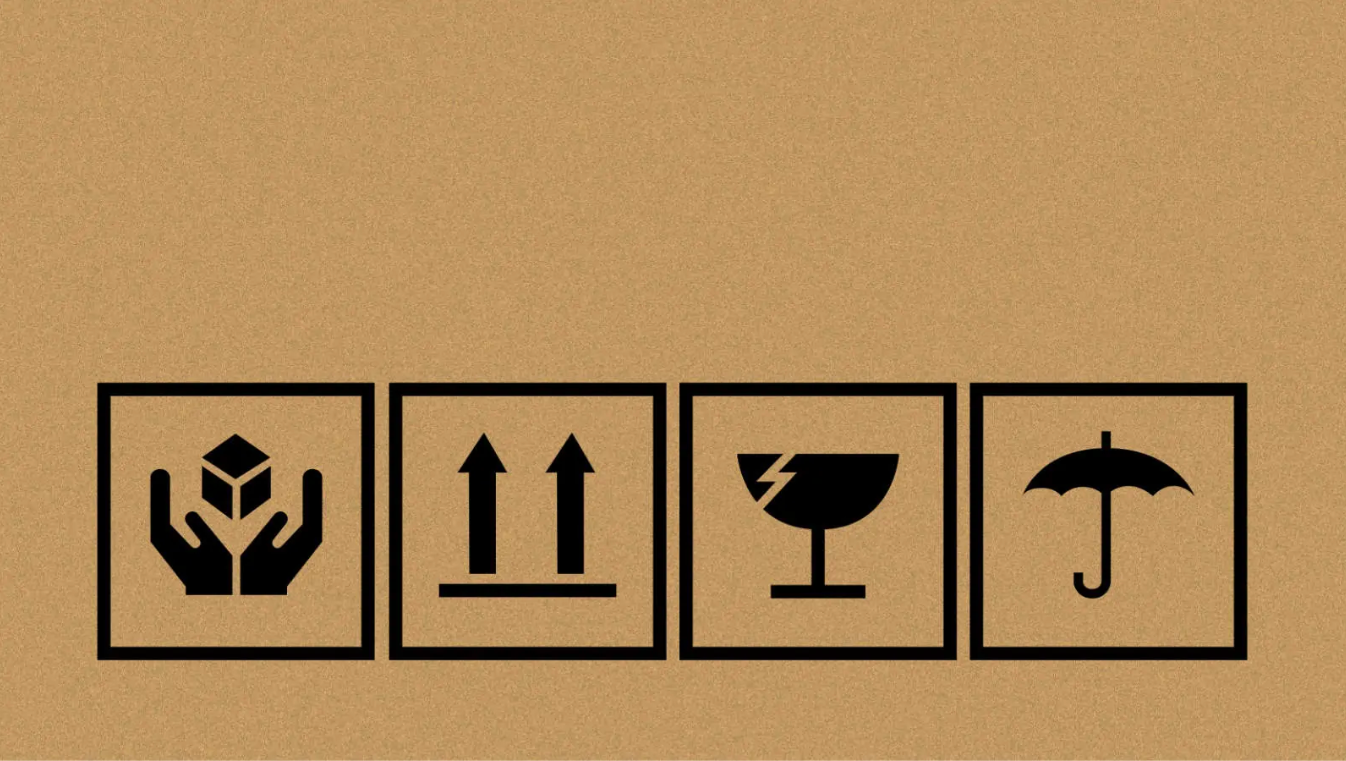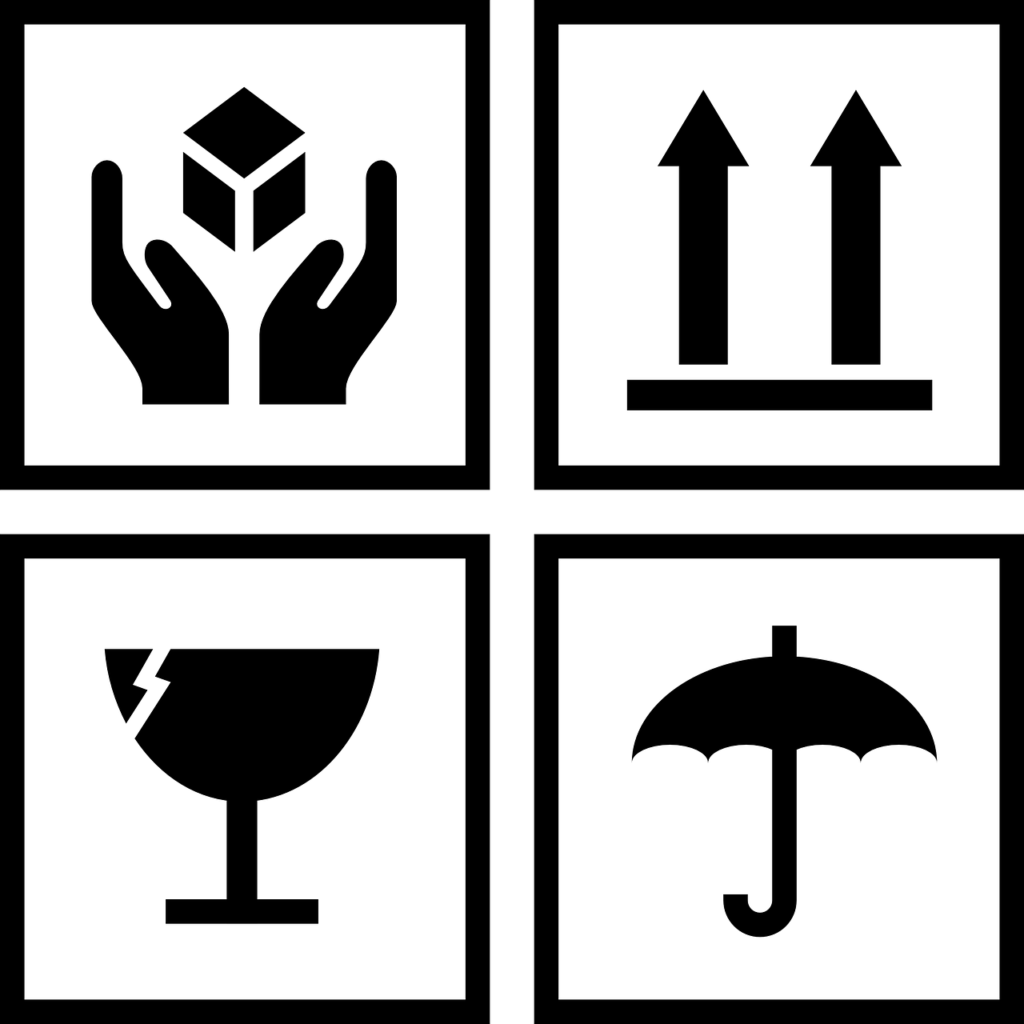Learn How to Read the Warning Symbols on Packaging


Subscribe now! Receive 15% discount.
Don’t miss out – get 15% off your first order when you join the newsletter. It’s fast, free, and kinda smart.
You're now subscribed!
In this article:
The recent spotlight on packaging best practices has familiarised the consumer segment with more warning symbols and recyclable packaging symbols than ever. That's not surprising, given the e-commerce growth and all sustainable initiatives developed in recent years.
However, there's more to packaging symbols than the Mobius loop. You may have also noticed a variety of transport icons, care icons and so on. And as intuitive as most of these warning packaging symbols may be, it's always good to know a little extra before breaking your back trying to pick up a heavy box.

Table of contents
- A brief history of warning symbols
- What's the role of warning symbols on packaging
- Copyright & usage regulations
- A list of warning symbols categories, icons & meaning
- Conclusions & complimentary readings
A brief history of warning symbols on packaging
The most recognised packaging symbol in the world, the radiation warning symbol or the Trefoil, was designed in 1946 at the initiative of the University of California Radiation Laboratory in Berkeley. But do we know how to read it? Chances are that the answer is no.
The radiation trefoil was first created as a "doodle" by a team of researchers who were eager to create a warning symbol for this novel class of hazardous material. The trefoil symbolises an atom's activity and was drawn in a strong colour scheme (magenta-black) to stand out on any surface and material.
However, the blue proved to be unpopular, and after various colour testing, it was discovered that, from a distance, magenta on yellow best represented the idea of danger. This design eventually became the norm in early 1948.

If we see any variation of this warning symbol on packaging, we know to keep our distance. We understand there's a hazard present, but that's where the information ends for most. The main purpose of the warning symbol is achieved. But we only understand how to proceed once we know the full extent.
How do we interact with warning symbols we don't understand?
If you see a transit packaging symbol that says "way up", we know how to handle the said box. Same for the fragile symbol. But how do we proceed with packaging that has a warning symbol that we don't fully know how to read?
The Trefoil warning sign is a prime example of how easy is to think we know a symbol. As it happens, this hazardous packaging symbol has been read incorrectly for so many decades that they had to create a follow-up to clear the air. (pun intended)

The IAEA discovered that the Trefoil symbol was not widely understood around the world, and there was an urgent need for another symbol. The warning symbol from above was created to stop people from around the world from handling and disassembling deadly material.
Safe to say, not many of us we'll be exposed to a radiation symbol; this is just an example of how our cognitive bias can prove a hazard. It's no secret that there's a chance of injury or product damage when mishandling a package, so learning how to read the warning symbols on the packaging is crucial.
Copyright© & Trademark™ regulations of packaging symbols
Please note that the files you see on this page are only intended for usage with the proper authorisation from the copyright holder or regulatory organisation. You must confirm that you have the right to use these logos and follow the proper usage instructions.
Packhelp provides and owns the rights for several packaging symbols, which you can explore for FREE when you open the Design Studio. Take me there!
Take me there!
A list of packaging warning symbols, icons & meaning
There's more to packaging warning symbols than meets the eye, and while some icons look intuitive, others can be tough to read. For this purpose, trialling them into categories might do the trick for a bit of context. How many icons can you think of when reading the two categories below?
- Transit packaging symbols
- Chemical pictograms (warning symbols on chemical product packaging)
Which are the most common packaging icons used in transit?
These are the most popular transit packaging symbols, and each can appear printed in different styles and accompanied by text with indications.
 |
Fragile → occasionally followed by the same word, this symbol means there are delicate items inside (not necessarily made of glass) |
 |
Keep dry → the packaging's umbrella and raindrop sign denote that the box (and its contents) should be kept dry. Another option is to display only the umbrella. |
 |
Handle with care → two hands around a box is another typical packing sign that indicates to the user or handler that the carton should be handled. |
 |
Do not open with a knife → a cross next to the image of a knife indicates that the package should not be opened with a knife to prevent damaging the contents inside. |
 |
This way up → the direction towards which the packaging should be stored or transported is indicated by a horizontal line with two vertical arrows pointing up. |
Which are the most common hazardous chemical pictograms?
 |
Explosive (GHS01) → Examples of such materials include cellulose nitrate, which, given the correct conditions, such as the presence of an ignition source, can violently disintegrate and/or ignite. |
 |
Flammable (GHS02) → Liquids with a flashpoint ≥ 23°C and ≤ 60°C. This category also includes gas oil, diesel and light fuel oil with a flashpoint range between ≥ 55°C and ≤ 75°C |
 |
Oxidizer (GHS03) → Oxidizers are substances that can burn and can also be gases, liquids, or solids. The most potent oxidising chemicals can start or exacerbate flames. E.g: Calcium hypochlorite (used in swimming pools as a source of chlorine and is comparable to household bleach.) |
 |
Compressed gas (GHS04) → This pictogram more closely relates to the storage conditions than the actual qualities. High-pressure gases like propane (the fuel for your barbecue), liquefied gas (nitrogen), and chilled liquefied gas (such as carbon dioxide). |
 |
Corrosive (GHS05) → Many salts and surfactants fall under the category of being corrosive to the eyes, with corrosive effects being shown at concentrations as low as 1%. |
 |
Toxic (GHS06) → This is by far the most recognisable warning symbol and it refers to poisonous compounds that can enter the body by three different routes: eating, skin or ocular contact, and inhalation. |
 |
Irritant (GHS07) → Without further context and knowledge of the hazards, this emblem can be challenging to understand. This symbol can be seen on household items such as washing liquid or laundry powder. |
 |
Systemic Health(GHS08) → This sign represents compounds that provide long-term health risks, such as carcinogens (substances that cause cancer) and mutagens (substances that cause birth-defects). |
 |
Environment (GHS09) → This symbol covers a wide range of substances, including pesticides, herbicides, and biocides as well as organic solvents like white spirits and salts used in fertilisers. |
Conclusions
Using the correct packaging symbols on your boxes should be part of any health and safety training and can surprisingly positively affect how you conduct your business. Supply chain-wise, it saves time and ensures safety measurements for staff handling your parcels and the products inside. It saves your back and your business at the same time.
Warning symbols for hazardous substances should be looked upon with educational intent rather than through the business lens. Getting in touch with these notions should be part of early education, and it's regulated by international laws to have them properly displayed on packaging.
Now that you know first-hand how to read these signs, will you start showcasing them on your packaging?
Complimentary readings
What is the Role of Packaging Symbols in Sustainable Development









